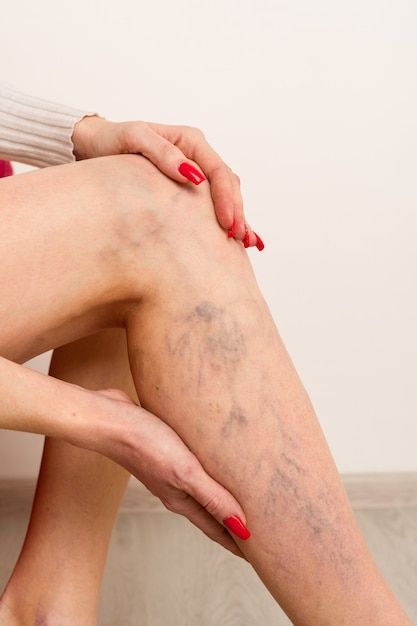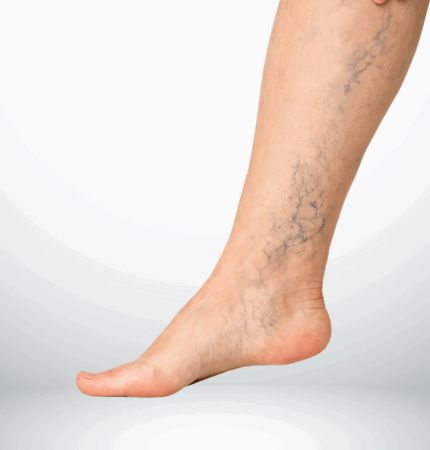Varicose Veins
All About Varicose Veins
Varicose veins are swollen, twisted veins located just under the surface of the skin. They are usually visible on the legs and thighs due to the high pressure exerted on the lower body veins when standing or walking. In healthy veins, blood flows smoothly toward the heart via one-way valves. When these valves become weak or damaged, blood can back up and pool, causing the veins to stretch, enlarge, and twist — resulting in varicose veins.
This condition ranges from mild cosmetic issues to painful, throbbing sensations that interfere with daily activities. In some cases, if not treated in time, varicose veins can lead to skin ulcers, blood clots, or chronic venous insufficiency.
Causes of Varicose Veins
Several risk factors contribute to the development of varicose veins. Understanding these causes is crucial for prevention and treatment:
Genetics: If you have a family history of varicose veins, your chances of developing them are significantly higher due to inherited vein weakness.
Prolonged Standing or Sitting: Occupations that require standing or sitting for extended periods, such as teaching, nursing, or office work, impede blood flow and increase vein pressure.
Pregnancy: During pregnancy, blood volume increases to support the growing fetus. This, along with hormonal changes, can weaken vein walls.
Obesity: Excess body weight exerts additional pressure on leg veins, leading to venous insufficiency.
Aging: As we age, veins lose elasticity and valves may weaken, especially after age 50.
Hormonal Changes: Menopause, birth control pills, or hormone therapy can affect vein strength and function.

Symptoms of Varicose Veins
Varicose veins may present with visible signs or cause discomfort and complications. Common symptoms include:
Visible, Twisted, or Bulging Veins: The most recognizable sign, often appearing as rope-like, blue or purple veins on the legs.
Aching, Heaviness, or Fatigue in the Legs: Especially after prolonged standing or walking.
Swelling in the Lower Legs or Ankles: A result of fluid accumulation from poor blood circulation.
Itching or Burning Sensation Around the Affected Veins: Sometimes misdiagnosed as skin conditions.
Skin Discoloration or Ulcers: In advanced cases, veins may cause skin to darken or ulcerate due to constant pressure.
Muscle Cramping: Particularly at night, due to improper blood flow.
Treatment Options for Varicose Veins
At Sree Sai Ayurveda Clinic, we believe in a comprehensive approach to managing varicose veins that includes conservative management, lifestyle changes, and minimally invasive interventions tailored to the severity of the condition.
1. Conservative Measures
These are first-line treatments for mild to moderate cases:
Wearing Compression Stockings: Helps improve circulation by applying pressure to the legs.
Elevating the Legs: Reduces swelling and improves blood flow.
Regular Exercise: Encourages better circulation and helps manage weight.
2. Lifestyle Changes
Making adjustments in daily habits can prevent varicose veins from worsening:
Healthy Weight Management: Reduces the pressure exerted on leg veins.
Avoiding Prolonged Standing or Sitting: Breaks and movement improve blood circulation.
Staying Hydrated and Consuming a High-Fiber Diet: Prevents constipation, which can strain veins.
3. Minimally Invasive Procedures
If conservative methods are not effective, the following treatments can offer lasting relief:
Sclerotherapy: A solution is injected into smaller veins, causing them to collapse and fade.
Endovenous Laser Ablation (EVLA): Uses laser energy to seal large affected veins.
Radiofrequency Ablation: Involves heating the vein wall with radiofrequency energy to close off the vein.
4. Surgical Interventions
For severe cases or veins that don’t respond to other treatments:
Vein Stripping or Phlebectomy: Removal of affected veins through small incisions. Typically done under local or general anesthesia.

Preventing Varicose Veins
Prevention is always better than cure. While you can’t change genetic predisposition, you can certainly adopt habits to minimize your risk:
Stay active with regular leg exercises and walking.
Avoid crossing your legs or sitting for too long without movement.
Keep your weight in check with a balanced diet and physical activity.
Wear comfortable shoes and avoid tight clothing that restricts blood flow.
Elevate your legs when resting to encourage blood return to the heart.
Ayurveda Perspective on Varicose Veins
In Ayurveda, varicose veins are linked to “Siragata Vata”, a condition caused by an imbalance in the Vata dosha, leading to improper circulation and valve function. Ayurveda therapies focus on detoxification, balancing doshas, and rejuvenating vein health through natural herbs, diet, and therapeutic massages.
Some key Ayurveda treatments include:
-
Panchakarma Therapies: Like Virechana (purgation) and Basti (medicated enema) to eliminate toxins.
-
Herbal Remedies: Formulations such as Ashwagandha, Guggulu, and Arjuna strengthen blood vessels.
-
External Applications: Oils like Sahacharadi Taila and Maha Narayana Taila help improve vein tone.
-
Dietary Adjustments: High-fiber foods, warm fluids, and anti-inflammatory herbs.
